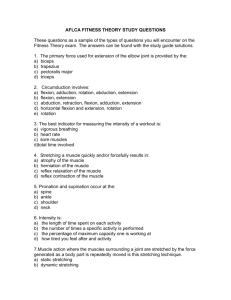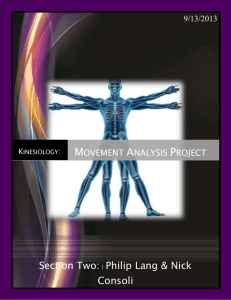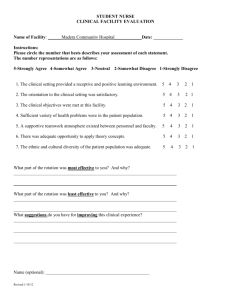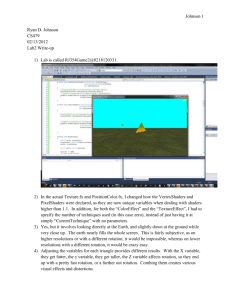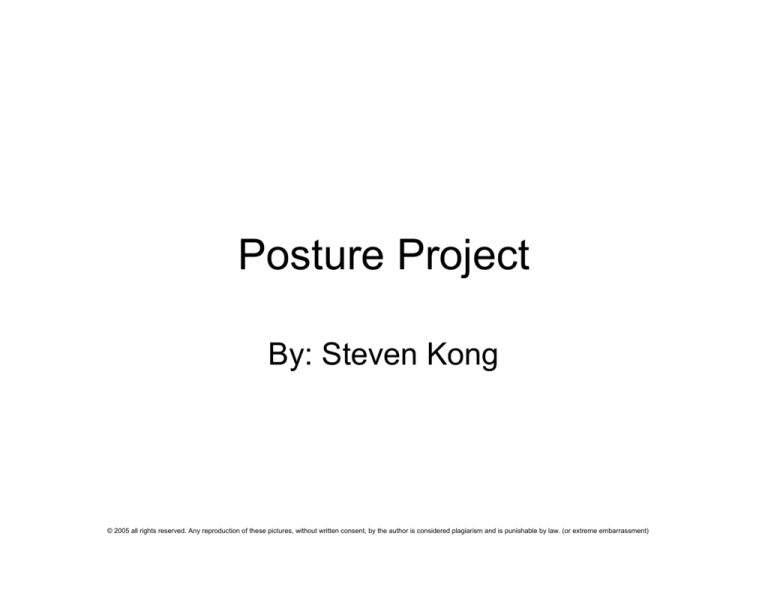
Posture Project
By: Steven Kong
© 2005 all rights reserved. Any reproduction of these pictures, without written consent, by the author is considered plagiarism and is punishable by law. (or extreme embarrassment)
Patient Profile
•
Name:
– Steven Kong
•
Height:
– 5’9 ½”
•
Weight:
– 182lbs
•
BMI: 1
– 26.3 (overweight)
•
Hip to Waist Ratio: 2
– 59
•
Blood Pressure
– 115/68
•
Resting Heart Rate:
– 57
•
Body Fat
– 13%
• *abnormalities found at end of posture
evaluation and seen by superscript
Posture Evaluation
Anterior View (AV)
• Plum alignment
– Trunk
– Head
• Yes
Lower Extremity (AV)
• Arch1
– Slight Pes Planus
• Sub talar
– neutral
• Tibial Rotation3
– (L) External Rotated
• Patella Position4
– (L) Frog Eyed (slightly)
• Leg Position
– Neutral
• Q angle
– 11 degrees (within normal)
• Muscle mass: symmetrical
Trunk/ Pelvis (AV)
• Iliac Crest:
– Symetrical
• ASIS
– Symetrical
• Abdominals
– No muscle difference
Upper Body (AV)
• Shoulder Position
– Neutral
• Shoulder Heights5
– ® depressed
• Head Position
– Neutral
• Muscle Mass
– Pecs6
• Left side more defined
– Traps7
• Left Side Higher
Posterior View (PV)
• Allignment with Plum
line
– Trunk
– Head
• Yes
Lower Extremity (PV)
• Calcaneal Position
– neutral
• Leg Position
– neutral
• Muscle mass
– Calves8
• ® body lower
– Thighs
• symetrical
Trunk/ Pelvis (PV)
• Spinal Alignment9
– Slight scoliosis
• Between scapula
• Iliac crest
– Neutral
• PSIS
– neutral
Upper Body (PV)
• Scapula Position
– normal
• Elevation/Depression5
– ® depression
• Protraction/Retraction
– none
• Rotation10
– asymetrical
– Winging
• ®
Lateral View (LV)
• Plum alignment
– Bisects:
•
•
•
•
•
•
•
Lat. Mall
Lat. Fem. Condyle
Greater Trochanter
Mid-Thorax
Acromion Process
Cerv. Vert. Bodies
Ex. Aud. Meatus
• Joint Positions
– Neutral
• Talocrural
• Knee
• Pelvic
Trunk (LV)
• Shoulder Position11
– Slightly forward
• Head Position12
– Slightly forward
• Lumbar Spine
– Concave
• Thoracic Spine
– Convex
• Cervical Spine
– Concave
Abnormalities
• 1) BMI
– Overweight, doesn’t count in muscle weight.
• 2) H/W ratio
– Moderate risk, doesn’t count body.
composition
• 3) Tibial Rotation
– Tibia is externally rotated possibly due to
genetics or previous injury to ankle.
• To help correct possible joint mob. to allow ankle
to and tibia to return to normal position.
Abnormalities
• 4) Patella Rotation
– Frog eyed patella, mainly caused by tibial rotation.
• Possible correction include fixing tibial rotation or
strengthening VMO.
• 5) Shoulder Depression
– Depressed shoulder, due to dominant arm. Not really
a way to correct.
• 6) Pec muscle
– Greater definition in one pec, and asymmetry
between muscles maybe caused by lack of strength
of scoliosis of back or genetics.
• Possible Correction by strengthening pecs, stretching back
muscles, correcting scoliosis.
Abnormalities
• 7) Trap Muscle
– Greater height in trap and more definition of left trap,
maybe due to lack of strength or tightness, or
genetics.
• Stretch or strengthen to fix.
• 8) Calf muscle
– Muscle length deviation possibly caused by genetics.
• Stretching of muscle may help correct
• 9) Scoliosis
– Slight curvature in back between scapulas. Unknown
cause, possibly genetics or poor posture.
• Strengthening back muscles, proper posture.
Abnormalities
• 10) Scapular Winging
– Scapular rotates at greater pace than other side.
Mainly due to playing throwing sport.
• Increase muscle strength, i.e. rhomboids.
• 11) Shoulder position
– Slight forward lean of shoulders, possibly caused by
tight pec minor or weak back muscles.
• Strengthen back muscle and stretch pec minor.
• 12) Head position
– Slight forward lean, possibly caused by tight
scalenes.
• Stretch scalenes.
Flexibility (Lower)
Active(degrees)
•
Ankle
–
–
–
–
•
Dorsiflexion*
Plantarflexion
Inversion*
Eversion*
9
50
35
12
12
56
39
17
135
140
125
28
47
45
30
145
32
63
53
35
Knee
– Flexion
•
Passive(degrees)
Hip
–
–
–
–
–
Flexion
Extension
Abduction
Internal Rotation
External Rotation*
Flexibility (upper)
Active
Passive
• Shoulder
– Flexion
– Extention
– Abduction
– Internal Rotation*
– External rotation*
165
42
180
42
48
175
56
196
45
70
Normal ROM*
• Ankle
–
–
–
–
Dorsiflexion
Plantarflexion
Inversion
Eversion
• Knee
= 20
= 50
= 20
=5
• Hip
–
–
–
–
–
Flexion
Extension
Abduction
In. Rotation
Ex. Rotation
= 125
= 15
= 47
= 45
= 50
– Flexion
= 140
• Shoulder
–
–
–
–
–
Flexion
Extension
Abduction
In. Rotation
Ex. Rotation
= 175
= 55
= 175
= 85
= 95
* Strakey, C., Ryan, J. (2002). Evaluation of orthopedic and athletic injuries.
2nd ed. Philidelphia: F. A. Davis Company
ROM deficits
•
Dorsiflexion
– Weak dorsiflexors or tight plantar flexors
•
Excessive Inversion
– Recurrent inversion ankle sprains
•
Excessive Eversion
– Previous injury: eversion ankle sprain
•
Hip Ex. Rotation
– Weak ex. Rotators or tight in. rotators
•
Shoulder In. Rotation
– Previous history of pitching
– Book not account for scapular movement
•
Shoulder Ex. Rotation
– Previous history of pitching
– Book not account for scapular movement
Fitness
– Curl ups
– 1 min, 50 beats, 1 crunch per 2 beats
• 25
– Excellent
– Push ups
– Number of push ups without stopping and following form
• 22
– Good
• Analysis:
– After fitness muscular endurance testing, I have good
muscular endurance in my abdomen, while there is
decrease in strength in pectoralis muscles. This could
have been do to the lack of activity at testing position




